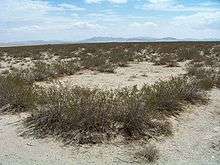King Clone

King Clone is thought to be the oldest creosote bush ring in the Mojave Desert. The ring is estimated to be 11,700 years old, making it one of the oldest living organisms on Earth. This single clonal colony plant of Larrea tridentata reaches up to 67 feet (20 m) in diameter, with an average diameter of 45 feet (14 m).[1][2][3]
Geography
The King Clone ring is on restricted-access public land in the central Mojave Desert, about 0.6 miles north of California Route 247 on Bessemer Mine Road near the towns of Lucerne Valley and Landers. It is within the Creosote Rings Preserve of the Lucerne Valley and Johnson Valley.[3]
Dating methodology
King Clone was identified and the age estimated by Frank Vasek, a professor at the University of California, Riverside. After Vasek hypothesized that the creosote ring was, in fact, one organism, Leonel da Silveira Lobo O'Reilly Sternberg (then a graduate student working in Vasek's lab), documented that plants within a ring had more similar characteristics, than those from other plant clusters. Vasek then used two methods to estimate the age of the ring. One method counted rings and measured the distance of annual growth, and the other used radiocarbon dating on pieces of wood found in the center of the ring, and measuring their distance from each other and the living bushes. The two dating methods yielded similar results.[3]
See also
References
- ↑ Creosote Bush: Long-Lived Clones in the Mojave Desert, Frank C. Vasek, American Journal of Botany, Vol. 67, No. 2 (Feb., 1980), pp. 246-255
- ↑ Weiser, Matt (2002-04-15). "The oldest living thing is a quiet survivor — High Country News". Hcn.org. Retrieved 2013-03-12.
- 1 2 3 "Creosote Rings Preserve, Lucerne Valley / Johnson Valley". Lucernevalley.net. Retrieved 2013-03-12.
External links
- official Creosote Rings Preserve website
- National Park Service: Creosote Bush webpage
- Jepson Flora Project: Larrea tridentata
- Botanical Record-Breakers: "The World's Oldest Living Thing"
Coordinates: 34°25′14″N 116°42′17″W / 34.420461°N 116.704727°W